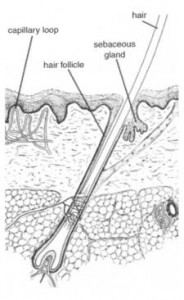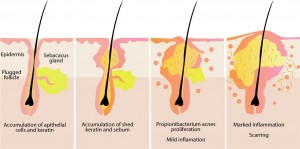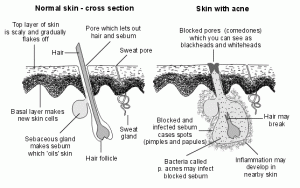Sebaceous Glands are very small glands in the skin that are only visible under the microscope. The glands are responsible for depositing an oily secretion on the hairs called sebum.
Where are Sebaceous Glands Located?
Sebaceous Glands can be found in all parts of the skin in the human body except soles and palms. These glands are generally located in the hairy parts of the body. These are connected to the hair follicles over the skin.
The gland can also be found in non-hairy regions of the skin, such as the eyes, nipples, Labia Minora, penis and nose.
Approximately 3 thousand Sebaceous Glands can be found per square inch of the skin. These glands are primarily found on areas like the face, scalp, chest and back. These mature and start active production of sebum when there is an onset of puberty in the person.
Sebaceous Glands on Penis
Sebaceous Glands on penis appear yellow or off-white in color. These are very small but can be seen because the penis tissues are very thin. The penis Sebaceous Glands are more noticeable in some persons than others. A few people view this as an abnormal condition and try to remove the glands by poking them. This should never be done for squeezing and poking may lead to an infected Sebaceous Gland.
Infected or blocked Sebaceous Glands of the penis can give rise to inflammation. Antibiotics are the medicines generally used for swollen penis Sebaceous Glands treatment. Patients should not try to break open the infected gland for it may spread the infection to other glands as well.
It is essential to maintain proper hygiene to prevent Sebaceous Gland infection of penis. Using your own clean towels, not sharing other’s undergarments and throwing away razors used for shaving the genital region should be practiced for prevention of Penis Sebaceous Gland infection.
Sebaceous Gland Function
Protecting the skin is the main function of Sebaceous Glands. Sebaceous Glands secrete an oily substance known as Sebum that lubricates the hair and skin of mammals. Large quantities of sebum protect skin and hair from water. It reduces the growth of microorganisms anywhere on the skin.
It is only because of the sebum that people can experience a wet skin even when they have not taken bath for days.
What is Sebum?
“Sebum” is the Latin word for “fat”. It is the oily secretion of the Sebaceous Glands which keeps the hair and skin moisturized and prevents them from cracking, turning dry and getting brittle.
The sebum comprises of lipids, wax and clusters of dead fat-producing cells. The percentage breakup of the composition of sebum shows it to be comprised of
- Triglycerides – 40%
- Wax monoesters – 25%
- Free fatty acids – 16%
- Squalene – 12%
Sebum is created in the Sebaceous glands. Following production, this oily substance is secreted through a small duct. From the gland it moves up the hair shaft and ultimately arises to the skin surface through the hair follicle. While coming up, it helps to push out any dust particle, germs or skin debris that may have somehow entered into the hair follicle.
It is because of Sebaceous Glands hair follicles remain free from foreign objects. The sebaceous glands can also come over the skin surface because of the follicles. Hair follicles and Sebaceous Sweat Glands are thus dependent on each other.
Sebum is generally odorless. But they can emit some odor while breaking down on the skin.



ليست هناك تعليقات:
إرسال تعليق